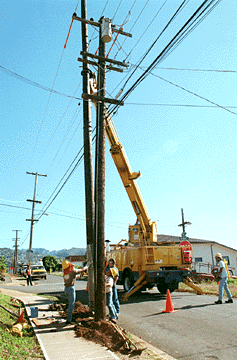
A Hawaiian Electric crew installs a utility pole in Kaimuki last week. The company is wrapping a stainless-steel mesh barrier around the bottom of all of its new poles to prevent termite damage. Photo By Ken Sakamoto, Star-Bulletin

A Hawaiian Electric crew installs a utility pole in Kaimuki last week. The company is wrapping a stainless-steel mesh barrier around the bottom of all of its new poles to prevent termite damage. Photo By Ken Sakamoto, Star-Bulletin
The company is wrapping a stainless steel barrier around each pole before installation to block the way to the wooden treat. So far, new poles wrapped with the steel mesh have gone in at Makakilo, Pearl Harbor, McCully and Hawaii Kai, HECO says.
Since spring 1995, the company has been wrapping about 10 poles a month, said Bill Atkinson, HECO structural designer.
Hawaiian Electric has made TERMI-MESH Termite Control System its standard method of protecting utility poles from subterranean termites.
HECO says the U.S. Department of Agriculture has found the stainless steel mesh 100 percent effective. Bug expert Julian Yates agrees, calling it foolproof.
Homeowners also can use the mesh to protect their homes from termites, said Yates, extension specialist in urban entomology, College of Tropical Agriculture and Human Resources, University of Hawaii.
Ken Takata, TERMI-MESH Hawaii spokesman, said the mesh is not widely sold but businesses sell the mesh-installation service. "All of the installers must be trained and accredited," he said, adding that there are about 25 certified installers in Hawaii.
Termite damage is costly, Yates said. "We've estimated the cost at $100 million annually in Hawaii alone. That's everything, houses, cost of treatment, you name it - water lines underground, electrical cables ... trees that we lose, reconstruction costs."
Atkinson, a HECO structural designer, explained the pole installation process. "We wrap the poles from bottom on up to a few feet above the ground line," he said. The material used is a very fine mesh, he added. "It's the same principle of using screens to keep insects out of houses. It's stainless steel with very fine mesh, so as to resist corrosion and the termites can't crawl through it."
The patented Australian system of protection against subterranean termites was developed as an alternative to chemical deterrents. The woven mesh has less than 1/64th of an inch between strands: too fine for termites to squeeze through, too hard for them to chew through, and too corrosive-resistant to be chemically attacked by termite secretions. The mesh comes in rolls 5 feet wide and 100 feet long.
Takata said two termite-ridden poles crashed down last month, one in Kailua and one in Kaimuki. Termite feasts had left them hollow, he said.
Atkinson said termite-weakened poles are prone to come down if struck by wayward vehicles. "Wind will do it sometimes," he added.
Calvin Tadaki, GTE Hawaiian Tel spokesman, said the telephone company treats its poles chemically for termites. While the steel-mesh approach sounds interesting, he said, the phone company is not going into it right now.